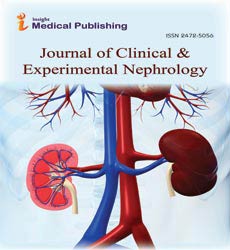Renal Failure Due to Intrinsic Renal Disease
Robert Gluck*
Department of Computer Science, University of Copenhagen, United States
- *Corresponding Author:
- Robert Gluck
Department of Computer Science,
University of Copenhagen,
United States;
E-mail: Robert@penmedicine.edu
Received: February 18, 2022, Manuscript No. IPJCEN-22-11494; Editor assigned: February 21, 2022, PreQC No. IPJCEN-22-11494 (PQ); Reviewed: March 07, 2022, QC No. IPJCEN-22-11494; Revised: March 11, 2022, Manuscript No. IPJCEN-22-11494 (R); Published: March 18, 2022, Invoice No. IPJCEN-22-11494
Citation: Gluck R (2022) Renal Failure Due to Intrinsic Renal Disease. J Clin Exp Nephrol Vol:7 No:1
Editorial
Renal failure is a loss of renal function leading to a fall of GFR to below 80 ml/min 1 and to an accumulation of creatinine, urea and other nitrogenous wastes. It is worthwhile at the outset to define renal failure and some common qualifying terms like severe, chronic or oliguric. Renal failure may be caused by any general circulatory disturbance that reduces renal perfusion, such as volume depletion, or cardiogenic shock. And also by any impediment to the excretion of urine formed by the kidney, such as urinary tract obstruction, or neurogenic or ruptured bladder and also by any disease of the renal blood vessels or parenchyma.
Traditionally these pathophysiologic categories come under the rubrics of pre-renal, post-renal and intrinsic or parenchymal renal failure. The intrinsic renal diseases may be further classified anatomically as primarily vascular, glomerular, tubular or interstitial in nature. In addition, a category of false renal failure should be added to this overall schema to cover patients with falsely elevated Scr.
The incidence of the different causes of renal failure varies with geographic, ethnic and socio-economic factors. In certain countries, a disease that is uncommon elsewhere may be responsible for many cases of renal failure. Such is true of septic abortion in Ghana Southeast Asia India and South Africa intravascular hemolysis in India and Ghana leptospirosis in Singapore, Thailand and the Philippines nephrotoxic herbal remedies in South Africa snake bites and malaria in Thailand, and severe gastroenteritis in India Indonesia and South Africa.
Patient age is also a factor. Myeloma kidney, renal artery stenosis and atheromatous renal emboli are causes of renal failure limited to older adults. Also, acute tubular necrosis is far less common in children after infancy than in adults.
There are many reasons for renal failure fall in Blood Pressure. Cardiac disease, volume depletion and vasodilation all may reduce arterial pressure and, as a result, renal perfusion. Since, about half of cases of renal failure are caused by pre-renal azotemia or acute tubular necrosis due to decreased renal perfusion; one should note any conditions that may reduce blood pressure and examine the records of patients' blood pressures for hypotension of even brief duration.
Drugs Used Therapeutically. Twenty to 30% of acute renal failure due to intrinsic renal disease is caused by radiographic contrast media, aminoglycosides or other drugs. Medications may also lead to chronic renal failure. Drug-induced renal damage comes about through a variety of mechanisms. The appendix lists the nephrotoxic drugs by their pathogenic action. Unfortunately, the causal role of drugs in renal failure may be overlooked. For example, commonly used medications, such as cimetidine or cephalosporins may be nephrotoxic only in rare cases. Furthermore, drugs taken for long periods of time may be erroneously assumed not to cause renal failure. In fact, while renal function may fall almost immediately following agents like rifampin or contrast media with other medications recorded not on the medication record, but on the intake and output sheet or on special forms used in the operating suite, emergency room or intensive care unit. Also, patients may not reveal their longstanding excessive use of medications, such as diuretics or laxatives taken for weight loss, and analgesics. Patients may obtain excess diuretics by seeing multiple physicians or by pilfering from their workplace in a pharmacy or hospital. Chronic headaches, backache or arthralgias can be a clue to analgesic abuse.
Thus, a complete listing of the patient's past and present medications must be assembled and the nephrotoxic potential of each agent must be considered. For newer drugs, this may require consulting with a nephrologist, searching the literature, or contacting the drug company.
Open Access Journals
- Aquaculture & Veterinary Science
- Chemistry & Chemical Sciences
- Clinical Sciences
- Engineering
- General Science
- Genetics & Molecular Biology
- Health Care & Nursing
- Immunology & Microbiology
- Materials Science
- Mathematics & Physics
- Medical Sciences
- Neurology & Psychiatry
- Oncology & Cancer Science
- Pharmaceutical Sciences
